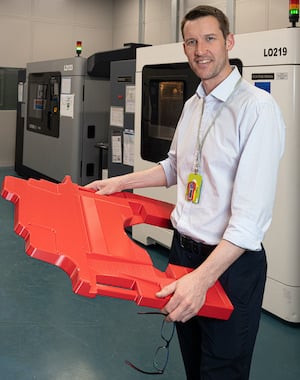British defense, security, and aerospace giant BAE Systems has added a fourth Stratasys F900 3D printer to its manufacturing plant in Samlesbury, UK, to continue its efforts to reduce costs and increase production agility.
In addition to the existing F900 series, the latest installment will also run around the clock. This is an integral part of BAE’s transformative “Factory of the Future” plan, which is located in a cutting-edge facility in Lancashire and incorporates the latest technology and manufacturing techniques, works seamlessly with human operators in an unprecedented, fully connected way. Today, Stratasys industrial-grade FDM additive manufacturing has been widely used in aircraft ground equipment operations, involving a wide range of applications in space models and design verification prototypes, manufacturing tools such as fixtures and fixtures, and end-use parts.
In addition to the existing F900 series, the latest installment will also run around the clock. This is an integral part of BAE’s transformative “Factory of the Future” plan, which is located in a cutting-edge facility in Lancashire and incorporates the latest technology and manufacturing techniques. Come together to work seamlessly with human operators in an unprecedented, fully connected way. Today, Stratasys industrial-grade FDM additive manufacturing has been widely used in aircraft ground equipment operations, involving a wide range of applications in space models and design verification prototypes, manufacturing tools such as fixtures and fixtures, and end-use parts.
The newly installed F900 by BAE Systems can not only improve 3D printing capabilities, but also help develop new 3D printing materials for tool applications. This includes carbon fiber-filled FDM Nylon 12CF material, which is used to create robust and lightweight repair and development tools for production lines.
According to Flanagan, FDM-based 3D printing technology particularly provides an opportunity to reduce the upfront cost of new productivity tools. This is especially true for drilling tools, maintenance tools, and other development tools that are often used in small amounts.

“Our Factory of the Future program is all about driving the future of fighter aircraft production with disruptive technologies and we’re working closely with our suppliers and wider industry to meet the challenges the UK Government has set out to us. Stratasys FDM additive manufacturing plays an important role in this initiative, as it helps us meet our overall company objectives to reduce costs and time-to-market,” says Greg Flanagan, Additive Manufacturing Operations Lead, BAE Systems Air.
BAE Systems has also achieved great success in identifying traditional manufacturing applications, which can be enhanced with high-performance 3D printing materials or replaced in some cases. This includes the use of durable ABS and ASA materials for various aircraft ground equipment, such as the cockpit floor cover of the Typhoon fighter jet. “Using our F900, the thermoplastic cover can be manufactured much faster than the traditionally manufactured version, and it is lighter and easier to move for the ground crew, so it can improve the efficiency of the maintenance, repair and overhaul process. Another benefit is, They can be printed in red – the color of all ‘disassembled before flight’ components,” he added.
The latest F900 was purchased from Stratasys’ local partner Laser Lines, and BAE Systems has been a Stratasys customer through the company since 2006.
Yann Rageul, Stratasys Europe, Middle East and Africa Region Manufacturing Solutions Director, said: “BAE System’s “Future Factory Plan”is a typical example of innovative companies seeking to use the latest advanced manufacturing technologies and processes to improve traditional production levels. We will continue work closely with the BAE team to explore new solutions to further expand the application range of additive manufacturing in production-this will help solve and solve the company’s current and future manufacturing challenges.”

